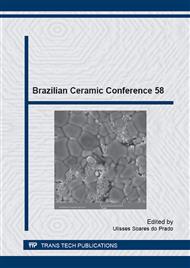p.60
p.65
p.73
p.79
p.84
p.90
p.96
p.102
p.107
Production of Mullite from Bentonite Clays and Alumina Residue
Abstract:
Among the ceramic raw materials, mullite is highlighted for presenting features which are of great interest for industry. However, the process through which this material is obtained requires pure reagents, raising the production costs. Therefore, this work is intended to obtain mullite from bentonite clays (source of silicon and aluminum oxides) and alumina residue, resulting from the Bayer process, thus becoming an interesting process from the economic and environmental standpoint. For this purpose, we made use of the thermal treatment in conventional furnace, temperature of 1500°C, heating rate of 5°C/min and dwell time of 60 min at maximum temperature. The synthesized samples were characterized by X-ray fluorescence (EDX), X-ray diffraction (XRD) and scanning electron microscopy (SEM) coupled to an EDS, besides the quantification of the phases present in the samples. The results revealed that mullite was the major phase produced, but corundum appeared as secondary phase.
Info:
Periodical:
Pages:
84-89
Citation:
Online since:
June 2015
Keywords:
Price:
Сopyright:
© 2015 Trans Tech Publications Ltd. All Rights Reserved
Share:
Citation:


